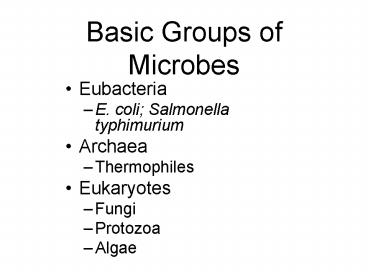Basic Groups of Microbes PowerPoint PPT Presentation
1 / 22
Title: Basic Groups of Microbes
1
Basic Groups of Microbes
- Eubacteria
- E. coli Salmonella typhimurium
- Archaea
- Thermophiles
- Eukaryotes
- Fungi
- Protozoa
- Algae
2
(No Transcript)
3
Diverse Microbes
4
Molecular Biology of Microorganisms
- Fundamental principles
- Important functions
- Nitrogen cycle
- Carbon cycle
- Detoxification
- Pathogenic bacteria
- http//vm.cfsan.fda.gov/7Emow/intro.html
- Anti-biotic resistance
- Biotechnology
- Engineering specific proteins
- Biomedical research
5
Advantages of Microbes
- Short life-cycle
- Doubling time of E. coli is about 20 min.
- Haploid
- Only have one copy of each gene
- Diverse living environments
- Evolution studies
- Commercially valuable bio-products
6
Central Dogma
- DNA
Replication
Transcription
Reverse Transcription
RNA
Translation
Protein
7
Replication
8
Transcription
9
Translation
10
Reverse Transcription
11
(No Transcript)
12
Genetics vs. Biochemistry
- Create mutants
- Genotypes
- Gene function
- Purify proteins
- Phenotypes
- Protein function
13
DNA Replication
- A fundamental process
- Experimentally demonstrated
DNA
DNA
DNA
14
DNA Replication
THREE HYPOTHESES FOR DNA REPLICATION
15
SEPARATION OF DNAS BY CESIUM CHLORIDE DENSITY
GRADIENT CENTRIFUGATION (a) Photo of DNA in
ultracentrifuge rotor made with UV light (b)
Densitometric trace of UV scan
16
PREDICTED DENSITIES OF NEWLY REPLICATED
DNA MOLECULES ACCORDING TO THE THREE
HYPOTHESES ABOUT DNA REPLICATION
17
14N15N
RESULTS OF CsCl GRADIENT ULTRACENTRIFUGATION EXPER
IMENT SHOWING DISTRIBUTION OF DNA DENSITY IN E.
coli CELLS AFTER 0 TO 4.1 GENERATIONS OF
GROWTH THIS EXPERIMENT ESTABLISHED THAT DNA
REPLICATION IS SEMICONSERVATIVE
18
ELIMINATION OF DISPERSIVE REPLICATION MODEL
THROUGH DEMONSTRATION THAT THERE ARE NO
SINGLE-STRANDED DNA MOLECULES WITH A MXTURE OF
HEAVY AND LIGHT ISOTOPES AFTER ONE ROUND
OF REPLICATION
19
Conclusion
1. DNA replication is semi-conservative 2. DNA
replication is dispersive
20
DNA Replication Process
DNA
DNA
DNA
21
THREE POSSIBLE WAYS IN WHICH DNA MIGHT BE
SYNTHESIZED AT THE REPLICATION FORK
22
Control
Ligase is mutated
EXPERIMENTAL DEMONSTRATION OF SEMIDISCONTINUOUS
DNA REPLICATION (a) Replicating T4 DNA
pulse-labeled with radioactive precursor for
2-120 seconds (b) When T4 DNA ligase was mutated,
only small fragments of DNA were labeled

